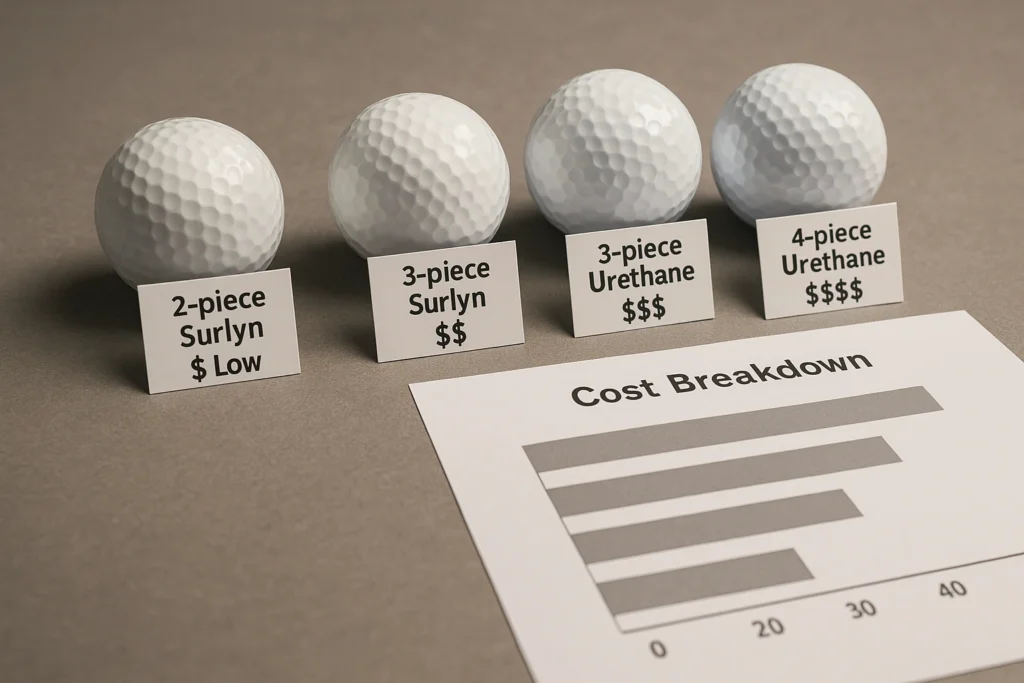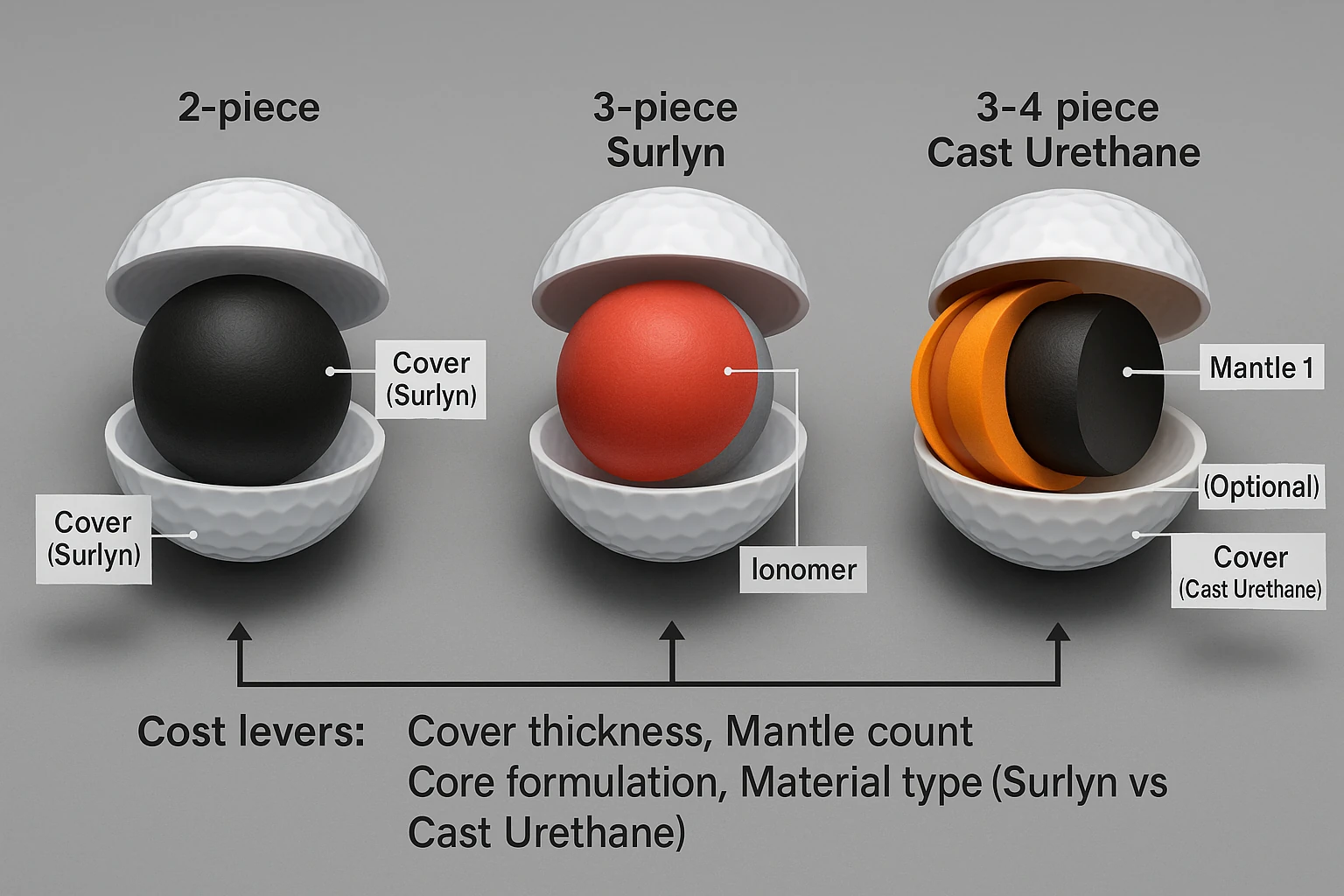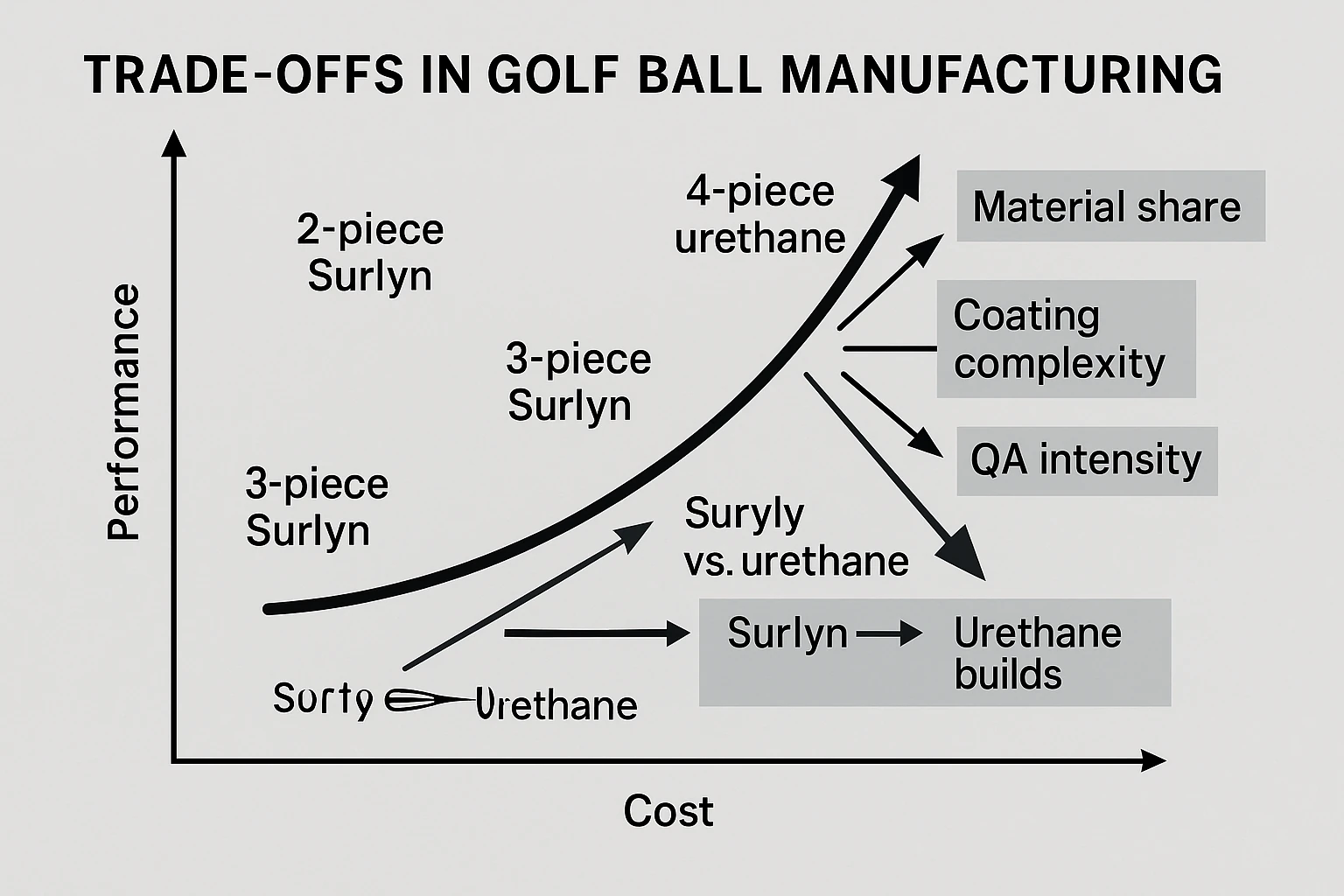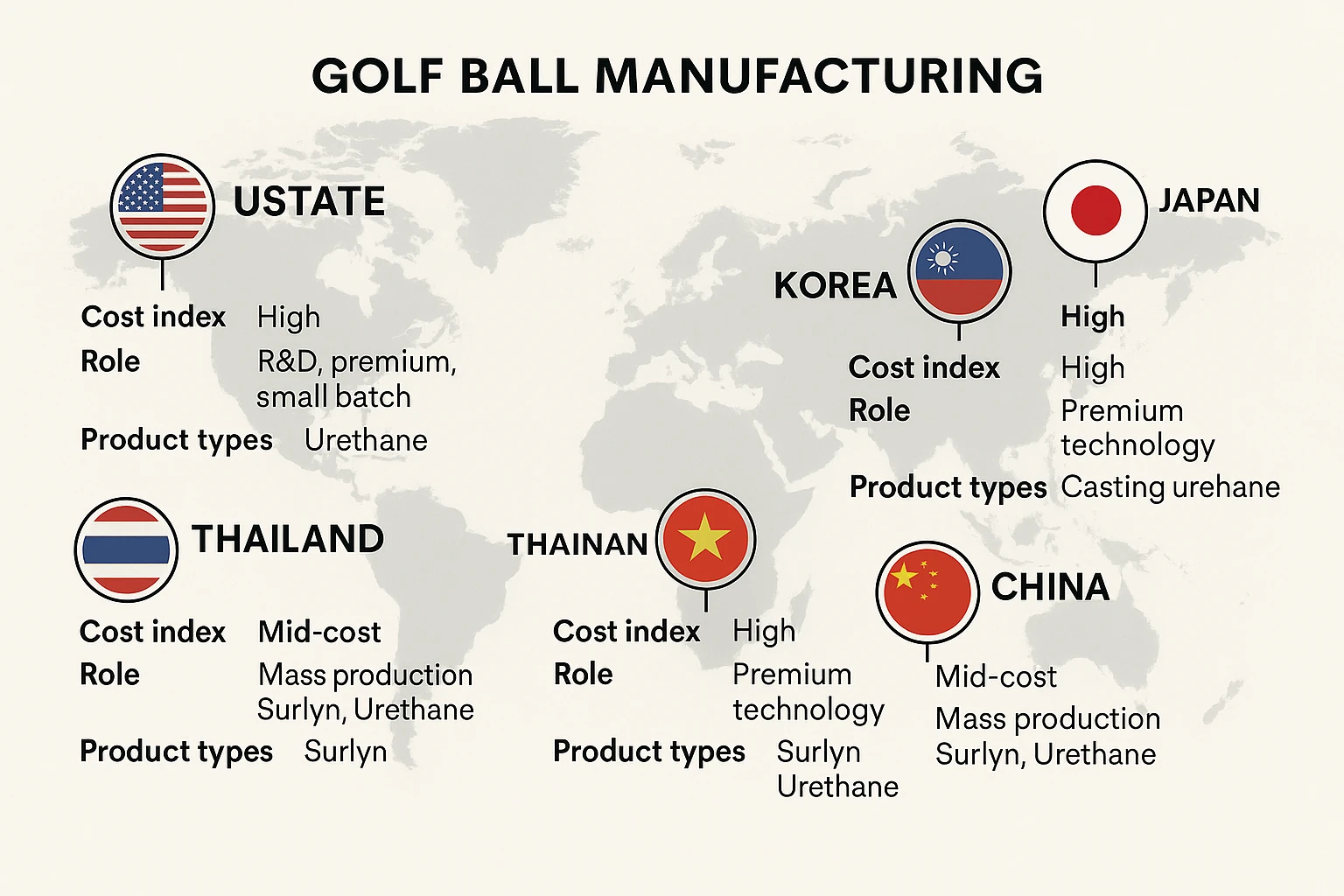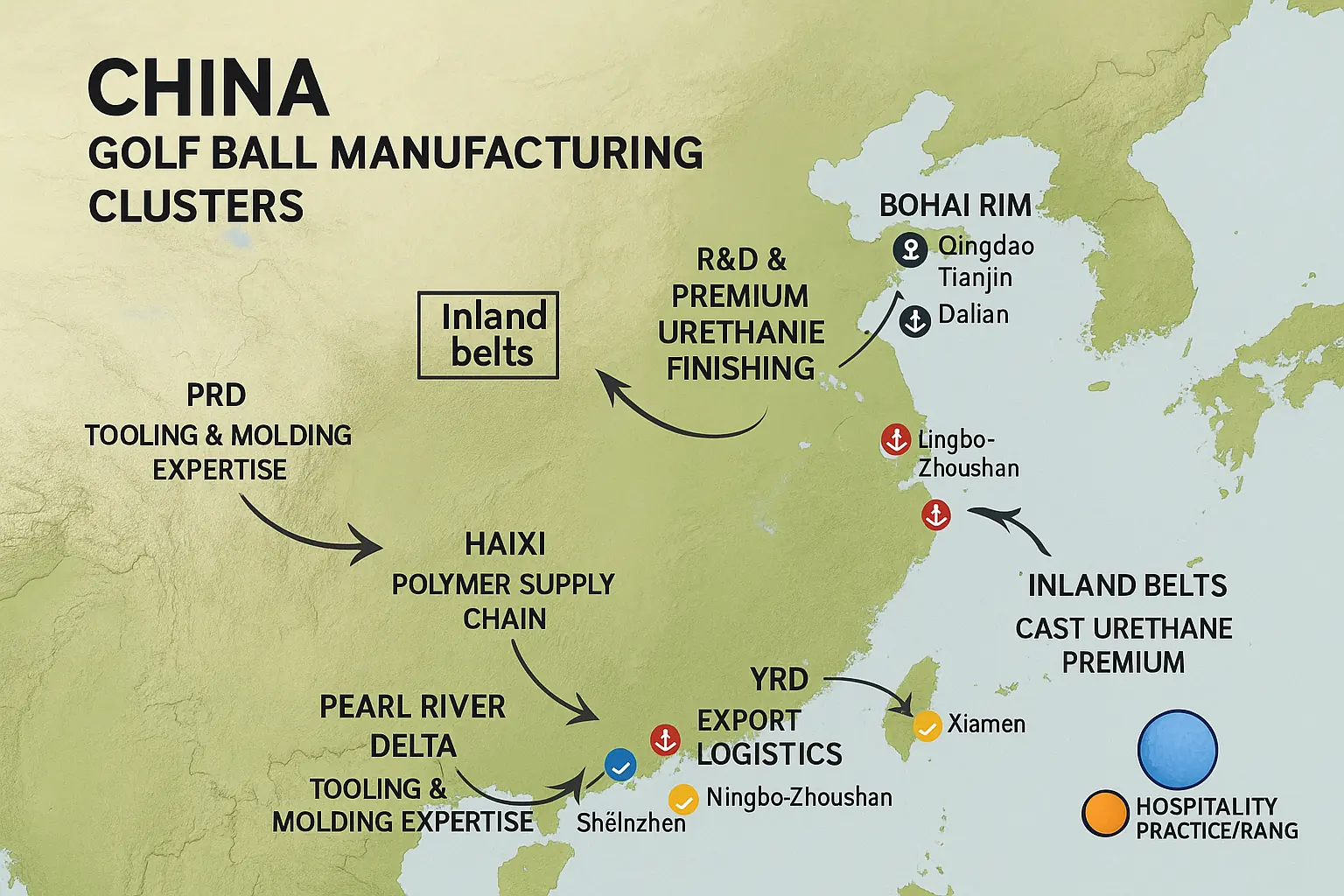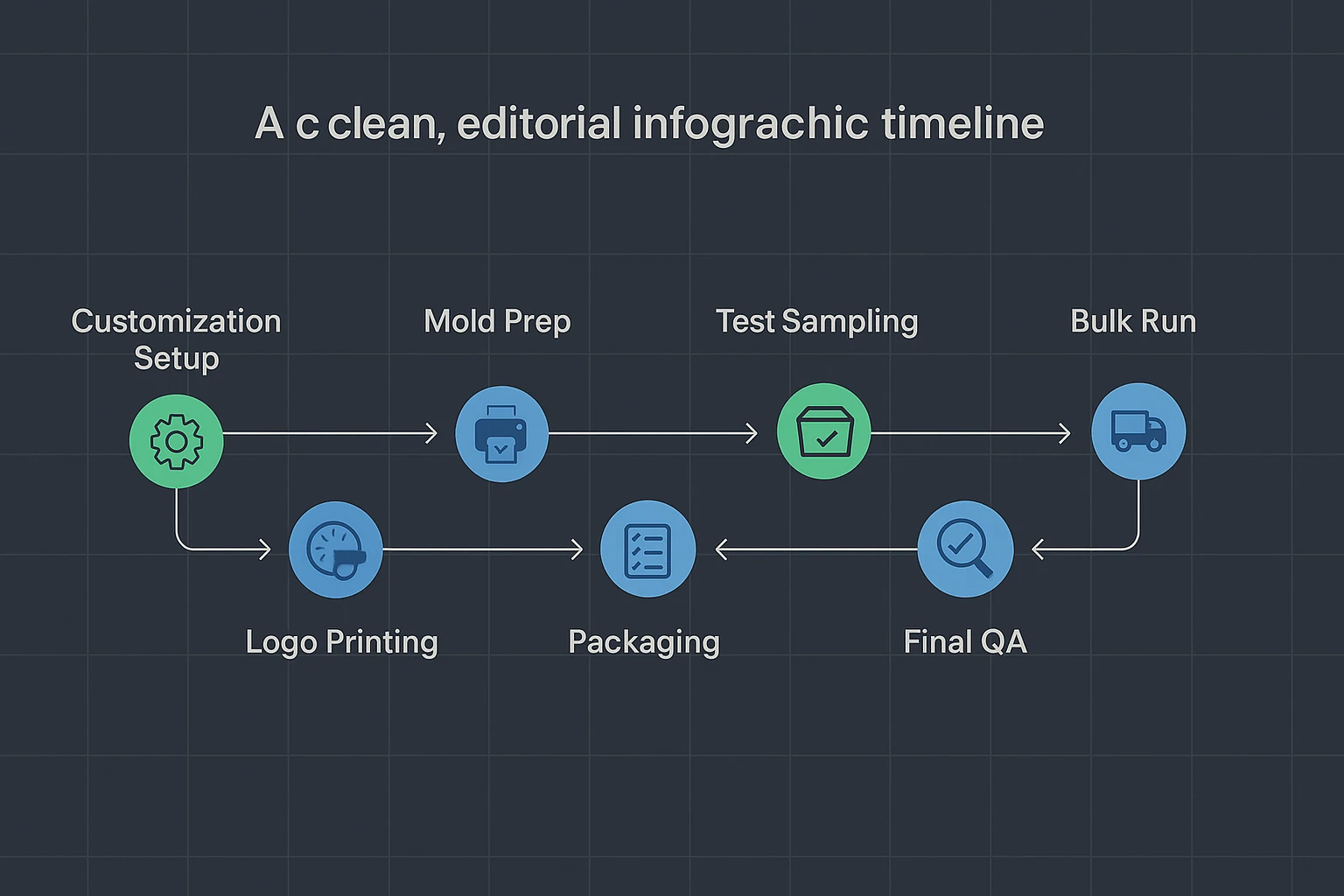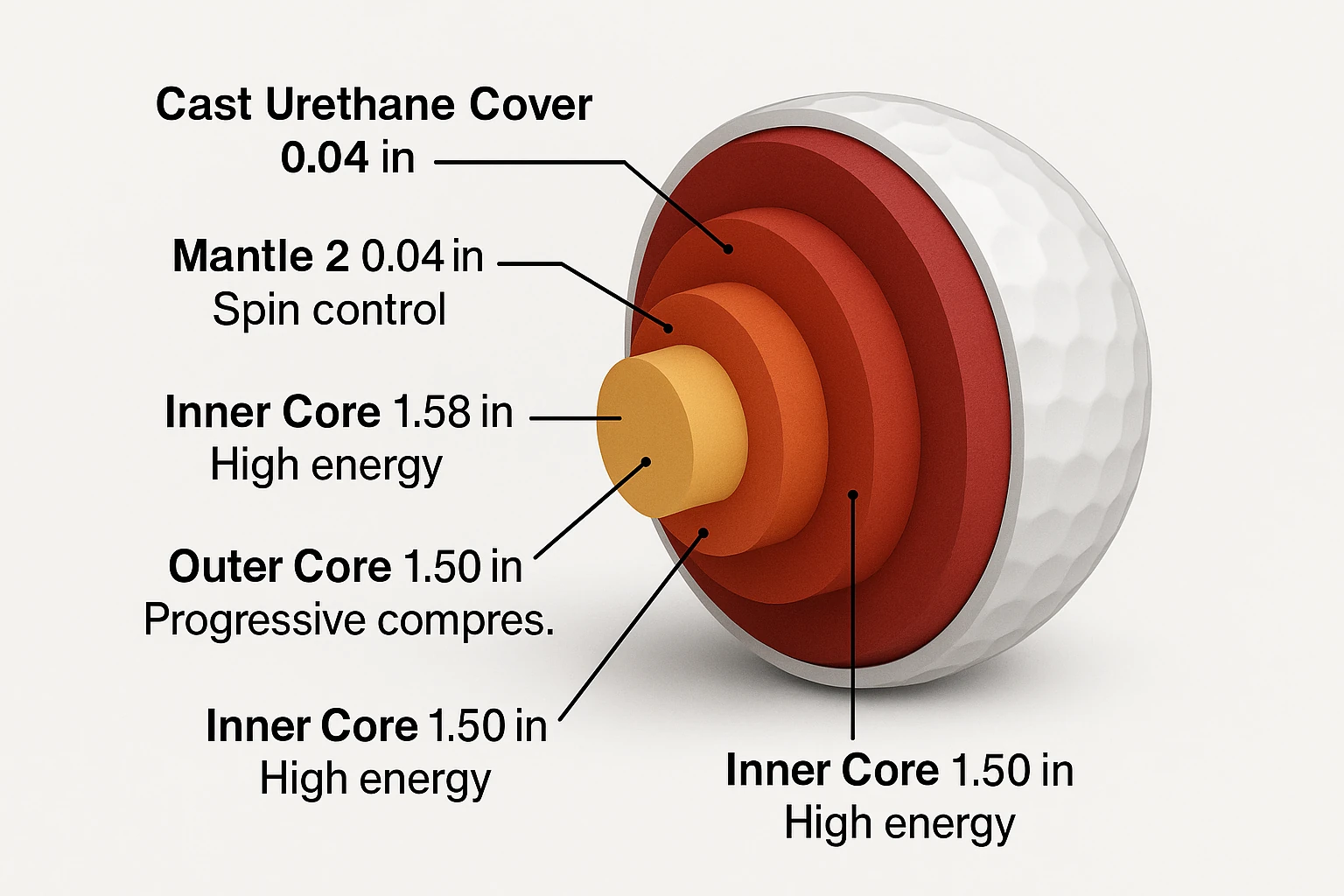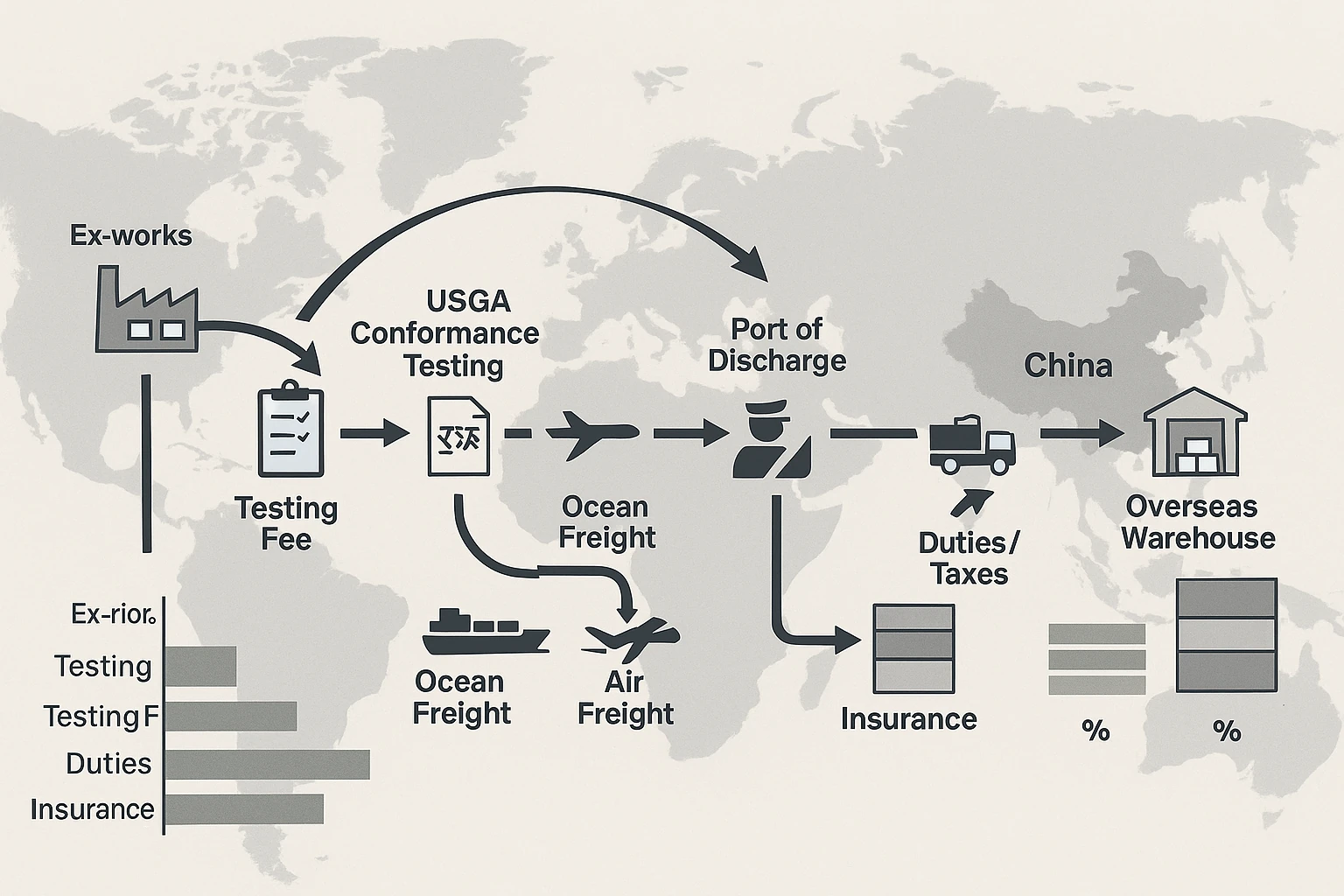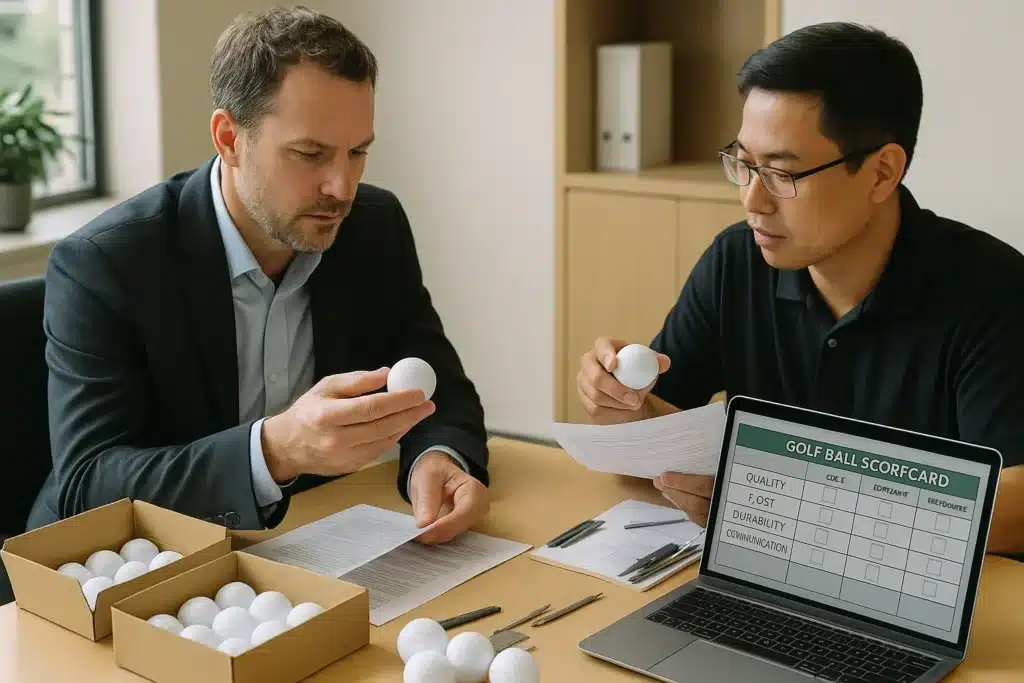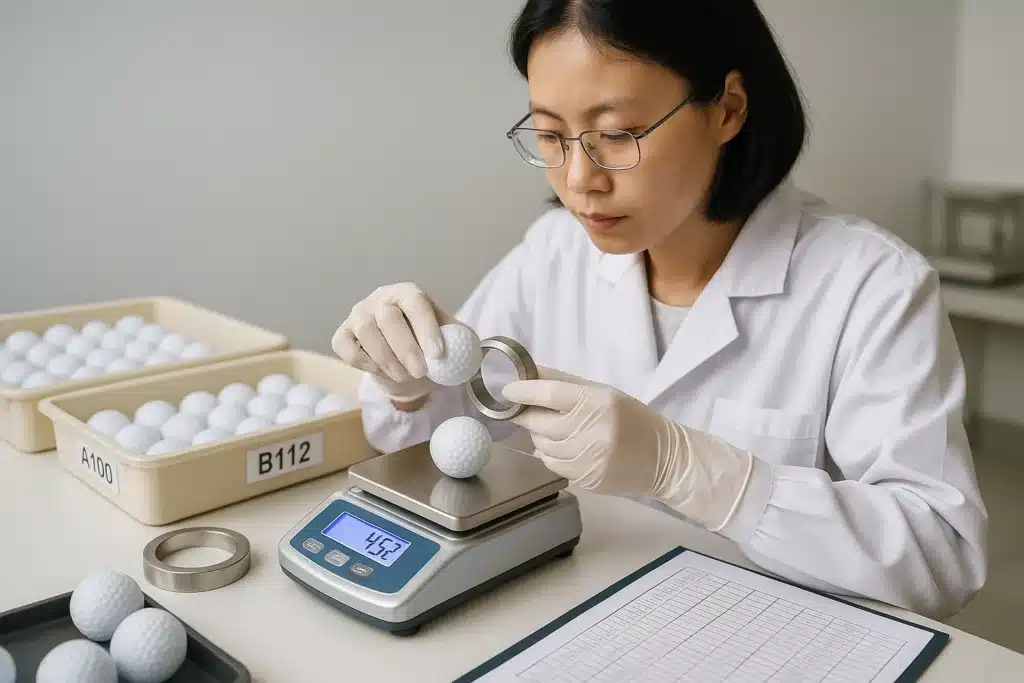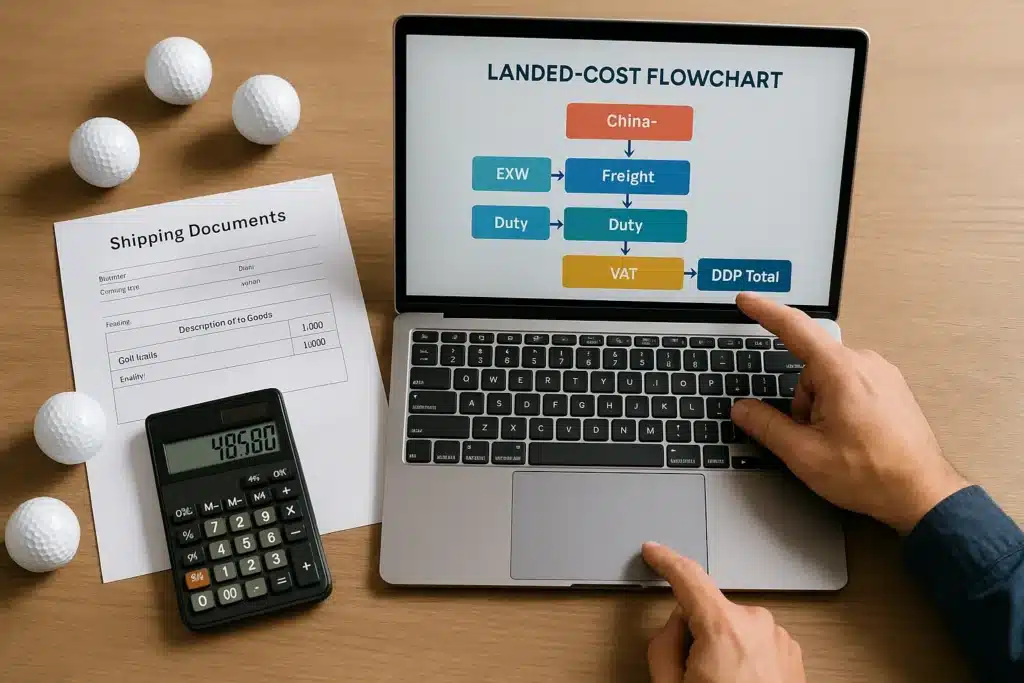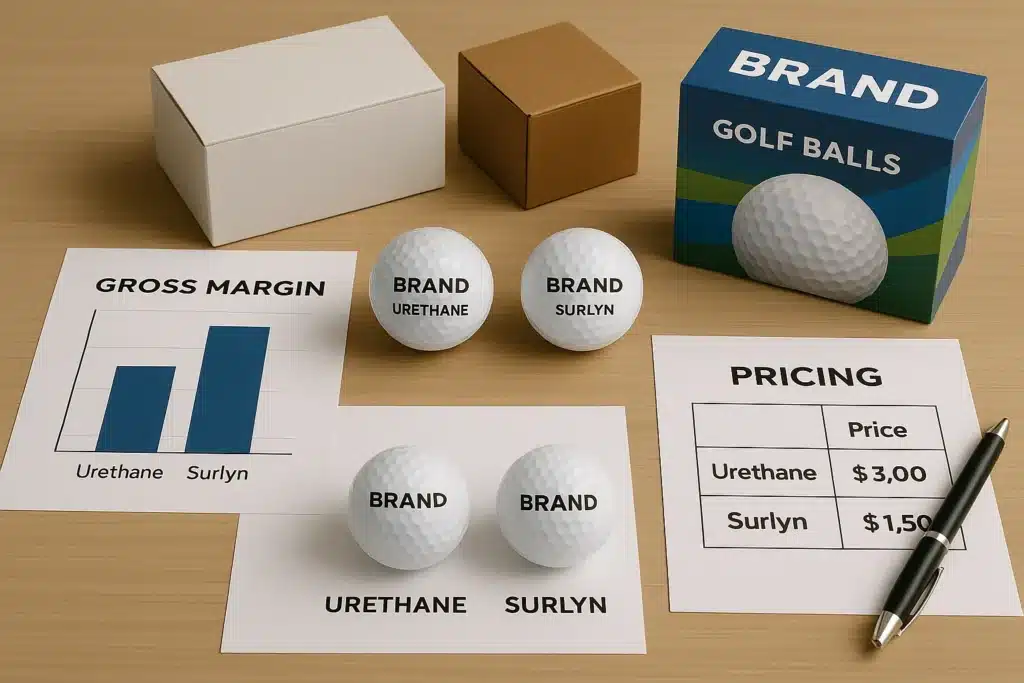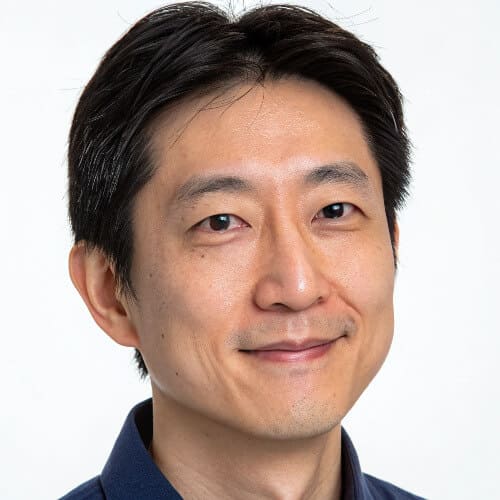Short answer: the cost to manufacture golf balls in China, quoted as EXW for blank & bulk orders, typically falls into these bands:
- 2-piece Surlyn: US$6–12/dozen
- 3-piece Surlyn: US$10–18/dozen
- 3-piece cast-urethane: US$18–24/dozen
- 4-piece cast-urethane: US$22–30+/dozen
Ranges vary with material grade, tolerances, yield and MOQ; logos/boxes are priced per spec.
What’s the short answer for factory EXW by construction?
China EXW (blank & bulk) lands in four anchor bands—2‑piece Surlyn US$6–12/doz, 3‑piece Surlyn US$10–18/doz, 3‑piece cast‑urethane US$18–24/doz, 4‑piece cast‑urethane US$22–30+/doz. Actual quotes move with cover system, layer tolerances, yield discipline, and MOQ cadence.
What are the indicative EXW price bands for China factories?
Use the four bands as decision anchors; then request spec‑based quotes tied to your cover system, layers, tolerances, yield assumptions, and MOQ. That turns a range into a reliable number for your business plan.
Table 1|China EXW per dozen (blank & bulk, no logo box)
| Construction | Typical EXW Range (US$/doz) | Notes |
|---|---|---|
| 2‑piece Surlyn | 6–12 | Practice/promo → retail entry; depends on core recipe, shell hardness, MOQ. |
| 3‑piece Surlyn | 10–18 | Adds mantle; mid‑retail positioning. |
| 3‑piece cast‑urethane | 18–24 | Thin urethane cover claim; verify short‑game spin & coating durability. |
| 4‑piece cast‑urethane | 22–30+ | Tour‑leaning; higher tolerance/QA pressure. |
✔ True — Why ranges, not single numbers?
Prices vary with cover system (Surlyn vs cast‑urethane), layer count & tolerances, yield/QA cadence, and MOQ/lead time. Use the ranges as anchors, then request spec‑based quotes. Freight/tariffs are separate and depend on the route.
✘ False — “One price fits all regions/specs.”
Flat quotes without cover, tolerance, yield and MOQ assumptions are unreliable; treat them as a red flag until the spec is pinned.
What is the cost anatomy—what makes up one dozen’s EXW?
Materials dominate the ex‑factory price; conversion and QA come next; packaging, indirects, and pre‑shipment items round it out. Shares shift with construction and cover system—urethane chemistry and coating stacks push material and conversion upwards.
How are typical factory cost shares distributed?
Surlyn builds allocate more to the core and ionomer shell; urethane builds spend more on resin systems, coatings, and slower conversion. Tight Tour tolerances increase QA labor and scrap.
Table 2|Typical cost shares (factory perspective; per dozen)
| Cost bucket | 2/3‑pc Surlyn | 3–4‑pc cast‑urethane | Notes |
|---|---|---|---|
| Materials (core rubber & crosslinkers; ionomer/TPU/urethane; coatings & inks) | ~35–55% | ~40–60% | Urethane resin and coating systems push share higher. |
| Labor & conversion (incl. energy) | ~10–20% | ~15–25% | Urethane casting and multi‑layer assembly are slower/more manual. |
| Depreciation, tooling/fixtures & QA (incl. scrap) | ~8–15% | ~8–15% | Tighter Tour tolerances → higher QA/scrap pressure. |
| Packaging (sleeves/dozen box) | ~5–10% | ~5–10% | Gift boxes or specialty packs increase this. |
| Indirects & admin | ~5–10% | ~5–10% | quoting pure EXW |
| Pre‑shipment logistics, tariffs & compliance | ~3–8% | ~3–8% | Highly destination‑dependent. |
✔ True — EXW ≠ landed cost
Beyond EXW, include USGA/R&A conformance fees, export handling, insurance, and inbound duties. Ocean rate swings and tariffs can move landed cost by ~US$0.2–0.6 per dozen on identical specs.
✘ False — “EXW + freight = landed.”
Duties, brokerage, surcharges and compliance timelines add variance—budget them explicitly.
What moves price most across factories and regions?
Four levers dominate: cover system, layer count & tolerances, yield & QA cadence, and local factor costs (labor/energy/tariffs/logistics). These explain most cross‑region gaps at the same construction—focus your negotiation on levers, not on headline price alone.
How should you read the four price levers?
Cover system: Urethane costs more than ionomer; align spec to spin/feel before sourcing.
Layer tolerances: Tighter concentricity drives scrap; lock tolerances that map to your price band.
Yield/QA cadence: Thin‑urethane builds rework more; add buffers or run pilots before scale.
Local costs: Labor/energy/tariffs differ; compare EXW → landed under the same Incoterms.
✔ True — TPU is not cast urethane
Some suppliers advertise “urethane” covers, but most use TPU. Cast thermoset urethane (e.g., Pro V1/TP5‑class builds) delivers a different spin/feel profile. Confirm cover type before assuming Tour‑level quality.
✘ False — “All urethane covers perform the same.”
TPU cannot replicate cast thermoset urethane’s short‑game spin and wear profile.
Global manufacturing map & roles (US / TH / VN / KR / TW / JP / CN)?
Tour‑grade capacity clusters in Thailand/Vietnam/Korea/Taiwan/US/Japan. China leads on 2–3‑piece Surlyn volume and packaging breadth; stable thin‑urethane mass production is still emerging domestically—great for value builds, cautious for elite Tour specs.
Which regions play what roles, and what are typical relative costs?
Use a relative index with TH/VN = 100 baseline to compare apples to apples. Higher indices reflect wages, energy, and QA regimes; lower indices reflect scale and supply‑chain density.
Table 3|Relative cost index (same spec/volume; TH/VN = 100 baseline)
| Region | Role snapshot | Typical products & customers | Core strengths | Key constraints | Index — 3pc Surlyn / 3pc Urethane / 4pc Urethane |
|---|---|---|---|---|---|
| Thailand | Natural rubber upstream + major brand ball plants | Mid‑high to Tour‑grade OEM/brands | Raw‑material proximity; mature plants; stable QC/yield | Rising labor; tight high‑end capacity | 100 / 100 / 100 |
| Vietnam | Rapidly grown Tier‑1 OEM hub | Mid‑high; some Tour | Tax/cost edge; strong foreign‑managed ops | Tight booking; tech held by foreign owners | 95–100 / 95–100 / 95–105 |
| Korea | Legacy Tour‑grade chain (e.g., Nassau) | High‑end/OEM | Deep urethane know‑how; tooling strength | Higher labor cost | 110 / 110–120 / 110–125 |
| Taiwan | Multi‑layer veterans (e.g., Foremost) | Mid‑high/high | Tooling/formulation depth; consistency | Mid‑high wage/energy | 105–115 / 105–120 / 110–125 |
| USA | Brand flagships (Pro V1, Chrome, Tour B) | Top Tour & premium retail | End‑to‑end QC; fast NA delivery | Highest labor/EHS | 140–170 / 150–190 / 160–200 |
| Japan | Flagship/specialty small lots | High‑end niche | Craft, reputation | High cost; limited scale | 160–200 / 170–210 / 180–220 |
| China (Mainland) | Mass 2–3pc Surlyn; some “proto‑Tour” urethane | Ranges, gifting, mid‑retail/e‑com | Cost competitiveness; capacity; full packaging chain | Thin‑urethane stability gap | 85–95 / 95–115 / 100–120 |
Product archetypes & cross‑country price bands?
Across regions, 2‑piece Surlyn runs ~US$6–10/doz at TH/VN baseline and higher elsewhere; 3‑piece Surlyn ~US$10–15 baseline to US$18+; 3–4‑piece cast‑urethane ~US$18–25 baseline to US$30–40+ at US/JP flagships.
How do archetypes translate into region‑by‑region price bands?
Anchor to TH/VN; adjust for CN/TW/KR and US/JP as brand assurance and wage/energy step up.
Table 4|Archetype × process × TH/VN baseline × CN/TW/KR × US/JP
| Archetype | Typical process | TH/VN baseline ($/doz) | CN/TW/KR (US$/doz) | US/JP (US$/doz) |
|---|---|---|---|---|
| 2pc Surlyn (practice/promo) | PB core + Surlyn shell | 6–10 | 7–12 | 12–18+ |
| 3pc Surlyn (mid retail) | PB core + ionomer mantle + Surlyn shell | 10–15 | 12–18 | 18–25+ |
| 3–4pc cast‑urethane (Tour) | PB core + multi‑mantle + thin urethane shell | 18–25 | 22–30+ | 28–40+ |
China’s golf‑ball clusters: where should you source what?
PRD excels in fast‑turn practice/promo and packaging; Haixi mixes Surlyn and emerging urethane claims; YRD benefits from molds/injection clusters; Bohai and inland belts support range volumes and back‑end assembly to lower total cost. Match your spec and risk posture to each belt’s strengths.
What does each China cluster specialize in?
A one‑page sourcing map helps you pick the right suppliers and plan logistics.
Table 5|China clusters — positioning & typical use‑cases
| Cluster (CN/EN) | Positioning & strengths | Product focus | Good for |
|---|---|---|---|
| PRD (Pearl River Delta: Shenzhen–Dongguan–Huizhou) | Ball assembly, 2–3pc Surlyn/TPU, logo print, gift sets; dense accessories chain; ports (Yantian/Shekou/Nansha). | Practice/promo, LED/color balls, logo customization; some 3/4‑layer (mostly Surlyn or thick‑U). | Corporate gifting, events, ranges; e‑com fast turns; full gift‑box bundles. |
| Haixi (Fujian: Xiamen–Quanzhou–Zhangzhou) | OEM/ODM from Surlyn to urethane claims; strong packaging/printing; mature export teams; Xiamen port. | Mid‑retail/entry tour‑look; practice/promo; small‑lot urethane sampling. | Retail‑ready looks and story; 2–3pc Surlyn mid‑range; try 3‑pc U samples. |
| YRD (Yangtze River Delta: Ningbo–Taizhou–Wenzhou; Jiangsu: Nantong) | Newer OEM nodes + molds/injection/packaging clusters; Ningbo‑Zhoushan port. | 2–3pc Surlyn/TPU main; some urethane claims; practice & retail. | Fast engineering iteration; mid‑retail with delivery discipline. |
| Bohai Rim (Shandong: Qingdao–Weihai–Weifang) | Sports goods & export belt near Qingdao port; practice & accessories active. | Practice balls; growing whole‑ball capacity. | Range supply; large‑volume promo OEM. |
| Inland cost belts (Jiangxi/Hunan/Anhui) | Back‑end assembly/pack/label; cost relief for coastal masters. | Post‑process tasks for practice/promo. | Price‑sensitive orders; less time‑critical projects. |
What are indicative China cluster price/delivery bands (EXW)?
Use bands as negotiation handles; verify thin‑urethane claims with data before committing volume.
Table 6|China belts — price/delivery snapshot (EXW, US$/doz, typical volumes)
| Belt | 2/3‑pc Surlyn (practice/promo) | 3‑pc Surlyn (mid) | 3–4‑pc Urethane (thin‑U casting) |
|---|---|---|---|
| PRD (Guangzhou–Shenzhen–Dongguan) | 6–10 | 10–16 | 18–28 (limited; some thick‑U) |
| Haixi (Xiamen–Quanzhou–Zhangzhou) | 6–10 | 10–18 | 18–30 (some thin‑U; verify) |
| YRD (Ningbo–Taizhou, etc.) | 6–11 | 10–18 | 18–28 (Surlyn‑led; U to be vetted) |
| Bohai Rim / Inland belts | 6–9 | 9–16 | Back‑end focus; few full thin‑U lines |
MOQ, tooling & printing: when do add‑ons kick in?
Logos, sleeves/gift boxes, labels, and shrink‑wrap are charged per spec and amortized by MOQ; multi‑color or UV work, custom molds, and tighter cosmetics raise unit cost and lead time.
What are the common customization add‑ons and how are they charged?
Start with a simple two‑color logo and reusable dielines; complexity adds time and rejection risk.
Table 7|Customization add‑ons (fill with internal rate card)
| Item | Typical charging unit | What drives the price | Approximate cost |
|---|---|---|---|
| Pad/UV logo printing | Per color × ball | Color count, coverage, registration tolerance, rejection rate | $0.01–$0.04 per ball per color (pad); $0.03–$0.08 (UV/digital) |
| Box/sleeve/gift set | Per set | Paper/finish, inserts, magnet/foam, print effects | $0.40–$0.90 per set (basic sleeve+box); $1.20–$3.50 per set (premium finishes/inserts) |
| Custom dimple/outer mold | Per tool | Cavity count, steel grade, lead time | $2,500–$8,000 per outer mold; $6,000–$15,000 per dimple master (indicative) |
| Certification samples | Per model/year | Conformance fees, sample qty | USGA/R&A fees + $80–$200 per sample lot (factory handling, indicative) |
Compliance, logistics & landed cost?
Add conformance, export handling, ocean/air, insurance, and import duty to EXW. Depending on route and season, landed cost on identical specs can differ by ~US$0.2–0.6 per dozen.
What should your landed‑cost checklist include?
Think through the whole door‑to‑door journey before you place the PO.
- Conformance (USGA/R&A): samples, timelines, annual fees
- Ocean/air choice vs seasonality
- HS 9506.32 duties by market; DDP vs DAP expectations
- Insurance & carton test standards (drop/compression)
Are there 5‑piece balls?
Yes—but very limited. The mainstream remains 3/4‑layer. The iconic TaylorMade TP5/TP5x are five‑layer; core capacity sits in Korea (Nassau) and Taiwan (Foremost). Five layers target finer spin separation but increase complexity and unit cost versus 4‑layer builds.
Why do some brands choose five layers and how is it different?
The goal is finer spin separation—driver low spin, irons mid, wedges high—delivered via dual cores/mantles and a thin cast‑urethane shell (~0.45–0.60 mm). The trade‑off is more steps, tighter concentricity/coating control, higher yield pressure, and higher manufacturing cost.
What does the 5‑layer supply chain look like and who should buy it?
Snapshot: Representative model—TaylorMade TP5/TP5x. Main bases—Korea (Nassau), Taiwan (Foremost); some VN/TH packaging/adjacent ops. Global usage—small/non‑mainstream. Asia EXW—~US$20–30+ per dozen. Best fit—higher swing speeds/low handicaps seeking fine feel & spin stratification.
Buyer checklist for five‑layer
- Cast‑urethane ≤0.6 mm
- Dual mantle/core thickness & hardness as distributions
- Robot data: Driver/7‑iron/50‑yd wedge (speed/launch/spin/land angle)
- Consistency: OOR ≤ 0.003 in; Cpk (weight/diameter) ≥ 1.33; Cpk (layer thickness) ≥ 1.00
- Proven 5‑layer mass‑production history (yield, returns, wear photos)
What’s the key takeaway?
Use four anchored EXW ranges—2pc Surlyn US$6–12, 3pc Surlyn US$10–18, 3pc urethane US$18–24, 4pc urethane US$22–30+—then adjust for cover, tolerances, yield, and region. Custom branding/boxes are added per spec.
How should a first‑time buyer apply these ranges?
Pick your performance lane (promo/range vs mid‑retail vs Tour), choose the cover, set tolerances you’ll actually police, and buy volume in longer runs. Lock artwork/pack early to protect yield and cycle time.
What’s the conclusion?
To estimate the cost to manufacture golf balls, lock construction and region, apply the bands, add compliance and freight, and pressure‑test yield. Negotiate materials and tolerances—not just price—to land a repeatable landed‑cost model.
What do you do on your next RFQ?
Share layers/cover/compression, target volume/MOQ, and branding needs. Ask for resin‑index clauses and yield assumptions in the quote.
FAQ — cost to manufacture golf balls
How much does it cost to manufacture a golf ball at 50,000 units?
For a mainstream 2‑piece Surlyn, plan roughly US$0.55–$0.95 ex‑factory per ball (US$6.6–$11.4/dozen); 3‑/4‑piece urethane will likely be US$1.55–$2.60 per ball (US$18.6–$31.2/dozen) given cover chemistry and QC. Confirm whether packaging is in the unit price and whether scrap assumptions are baked into the quote.
Why are urethane “Tour” balls so much more expensive to make?
Urethane covers cost more and process slower: longer cure, tighter temperature control, higher scrap sensitivity, and multiple paint layers add up—raising the cost to manufacture golf balls versus ionomer builds. The feel/spin gains come from precise chemistry and surface quality that demands more inspection.
What’s the cheapest way to add custom logos?
Keep one‑ or two‑color pad print, reuse plates, and align artwork across SKUs; each extra color or position adds cost and rework risk. Provide vector files and Pantone codes; approve proofs quickly. Consider putting full‑color branding on sleeves/boxes instead of the ball.
How big is packaging’s impact on unit cost?
Plain white box and basic sleeve might add US$0.07–$0.12 per ball; premium printed cartons with inserts can add US$0.15–$0.35 depending on board weight and finishes. Reuse dielines and avoid exotic finishes that trigger small MOQs.
How does MOQ 600 vs 1,200 affect unit price?
At identical specs, doubling MOQ from 600 to 1,200 dozen typically trims ~US$0.30–$0.80/dozen on 2‑piece Surlyn and ~US$0.80–$1.50/dozen on 3‑piece urethane by spreading setups, unlocking resin tiers, and smoothing paint/printing changeovers. Ask for a two‑run quote to see the break.
How much does it cost to manufacture golf balls in China (EXW)?
China EXW, blank & bulk: 2-piece Surlyn $6–12/dozen; 3-piece Surlyn $10–18; 3-piece cast-urethane $18–24; 4-piece cast-urethane $22–30+. Custom logos/boxes are priced per spec.
You might also like: Can Chinese Manufacturers Produce Tour-Grade Golf Balls?

